The ocean – Our Silent Ally

The ocean covers 71% of our planet and is much more than a vast expanse of motionless salt water. Beyond its undeniable majesty and mysterious nature, it represents the vastest ecosystem and is essential to survival on Earth. Dive into the silence of this complex universe to discover its unsuspected treasures.
The ocean provides a multitude of vital functions known as ecosystem services. These are the many benefits that humankind derives from healthy marine ecosystems without having to contribute to their functioning in any way. The Millennium Ecosystem Assessment (MEA) typology distinguishes four categories of ecosystem services: environmental regulation, resource provisioning, biodiversity and life cycle supporting, and socio-cultural services. According to the Oceans & Climate platform, the total value of the services provided by marine and coastal ecosystems each year amounts to over 20 trillion US-dollars.
Regulator of our Climate
The ocean plays a crucial role in regulating the world's climate. It acts as a gigantic reservoir to sequester and store carbon dioxide (CO2), produces oxygen and moderates extreme weather phenomena. According to estimates, the ocean have already absorbed between 20% and 30% of humanmade greenhouse gas emissions and around 90% of the heat generated by human activities, thus helping to regulate temperatures on a global scale. Carbon is absorbed through the physical-chemical phenomenon of gas dissolution in seawater and ocean circulation (physical pump) and through the biological process of photosynthesis made possible by marine algae and phytoplankton (biological pump). Together they fix CO2 and release oxygen. Thus, the ocean accounts for around 50% of the oxygen produced on the planet.
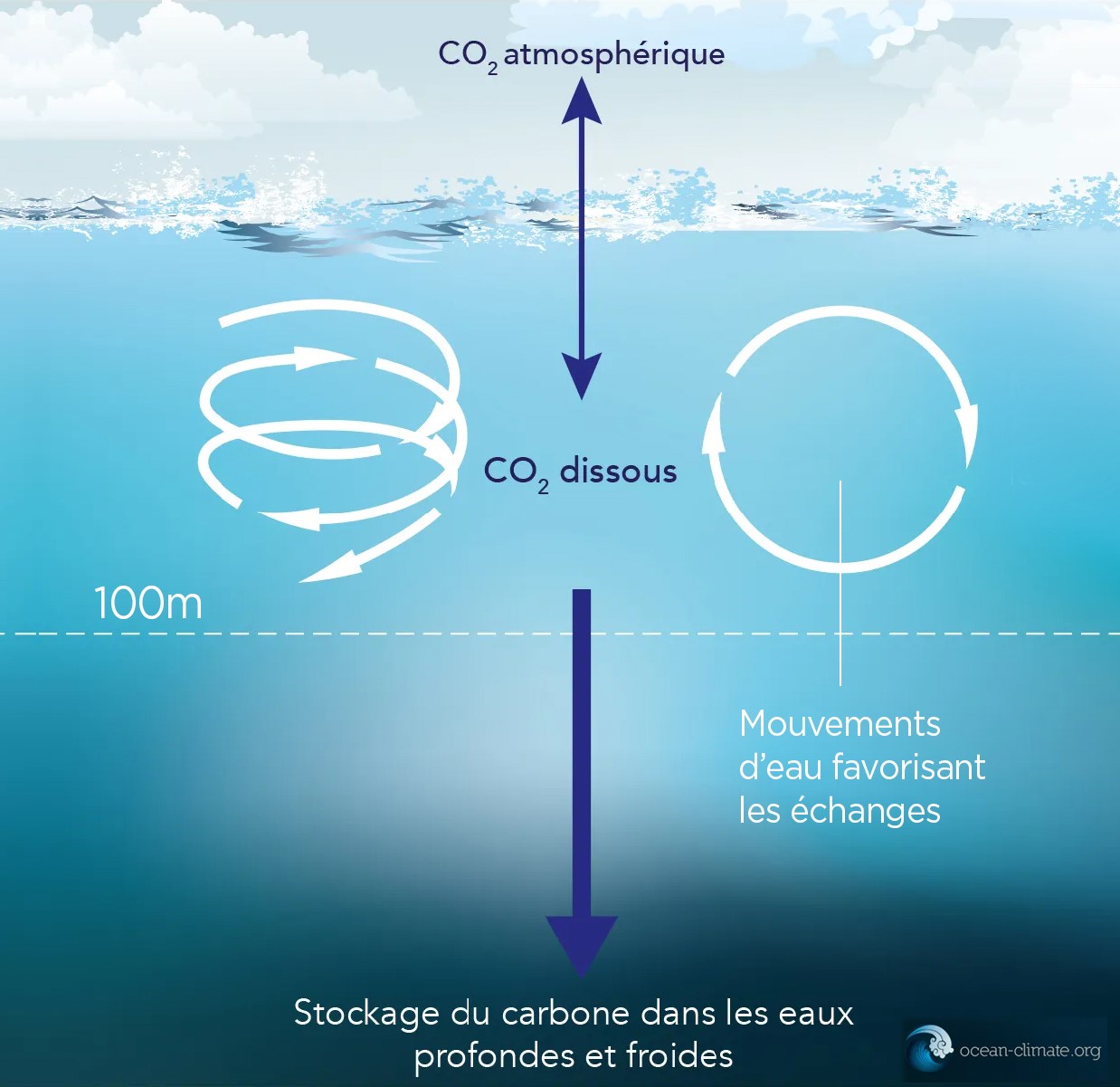 |
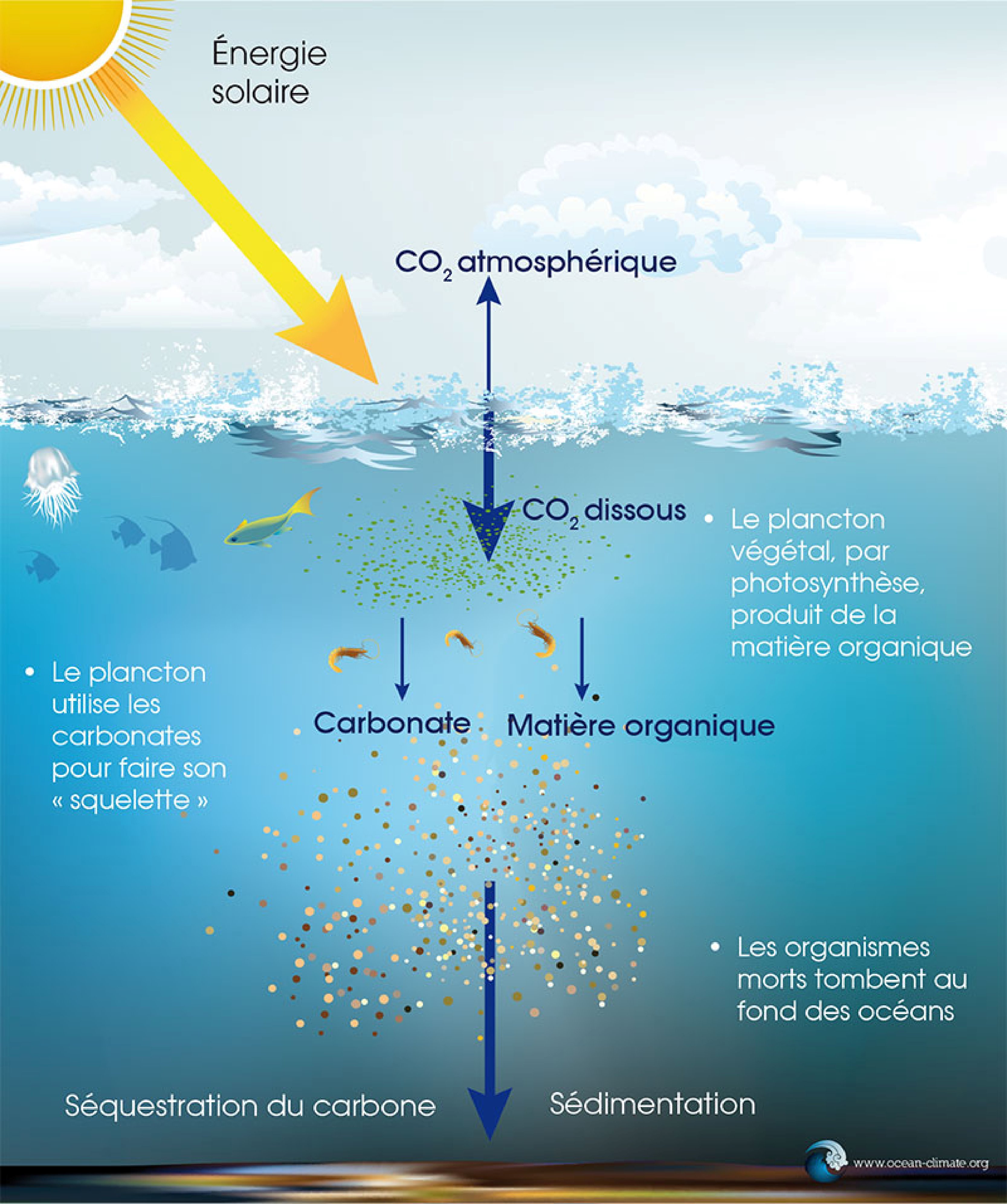 |
|
Physical carbon pump
|
Biological carbon pump
|
|
Source : ocean-climate.org
|
|
The deep seabed, where the remains of phytoplankton fall, is a powerful carbon sink where carbon remains stored in mineral form, firmly trapped in layers of marine sediments. Coral reefs also play a vital role in climate regulation by storing carbon in their limestone structures, thereby reducing the concentration of CO2 in the atmosphere. The ocean is estimated to contain 50 times more carbon than the atmosphere with which it constantly interacts by exchanging gases, water masses and heat. The great ocean currents - warm (or surface) like the famous Gulf Stream in the North Atlantic and cold (or deep) like the Antarctic Circumpolar Current - then redistribute this accumulated heat around the world, influencing regional climates.
Beyond the ocean in the strict sense, coastal ecosystems also play a crucial role in climate regulation. They temper extreme weather events such as storms and hurricanes by creating natural barriers that protect the land, thus reducing the damage caused by these phenomena to coastal populations and infrastructures. Mangroves, coral reefs, salt marshes and seagrass beds offer ideal protection against extreme tides, absorbing wave energy and stabilizing the coastline against erosion. Mangroves are among the most effective ecosystems for coastal protection, as their complex roots anchor themselves in the soil and prevent its disintegration, while their dense foliage acts as physical barriers against storms and tsunamis.
Provider of our Resources
The ocean is a vital source of nutrients for billions of living beings on Earth. According to estimates by the FAO (Food and Agriculture Organization of the United Nations), around 17% of the world's animal protein consumption comes from the oceans. A large variety of fish, crustaceans and mollusks are rich in mineral salts, omega-3 fatty acids and essential trace elements such as iodine needed by billions of people around the world to maintain a healthy, balanced diet. Commercial and artisanal fishing, aquaculture and sea salt production rely heavily on healthy marine ecosystems to ensure the sustainability of aquatic resources and guarantee food security for coastal communities and beyond.

The ocean is not only our food provider but also supplier of many promising materials. From building materials to various molecules useful for science, the ocean conceals treasures still largely unfathomed, which must be protected by ensuring their rational and sustainable exploitation.
As another significant service, the oceans are crucial transportation routes, linking continents and facilitating global trade. In the absence of land-based connections, the maritime routes traversed by ferries or large cargo ships are the vital arteries of the global economy, transporting goods and people from one continent to another. According to estimates, between 80% and 90% of goods reach us by sea. Seaports such as Rotterdam, Singapore, or Shanghai, as well as shipping companies, have become global freight's nerve centres and synaptic vehicles.
Protector of our Biodiversity
The ocean is the cradle of life on Earth and home to exceptional biodiversity, ranging from microscopic creatures measuring between a few millimetres and a few centimetres (such as the tiny Paedocypris progenetica - the world's smallest vertebrate fish, endemic to the Indonesian islands of Sumatra and Bintan) to large marine mammals reaching up to 30 meters in length - we all have in mind the largest animal on the planet, the blue whale.
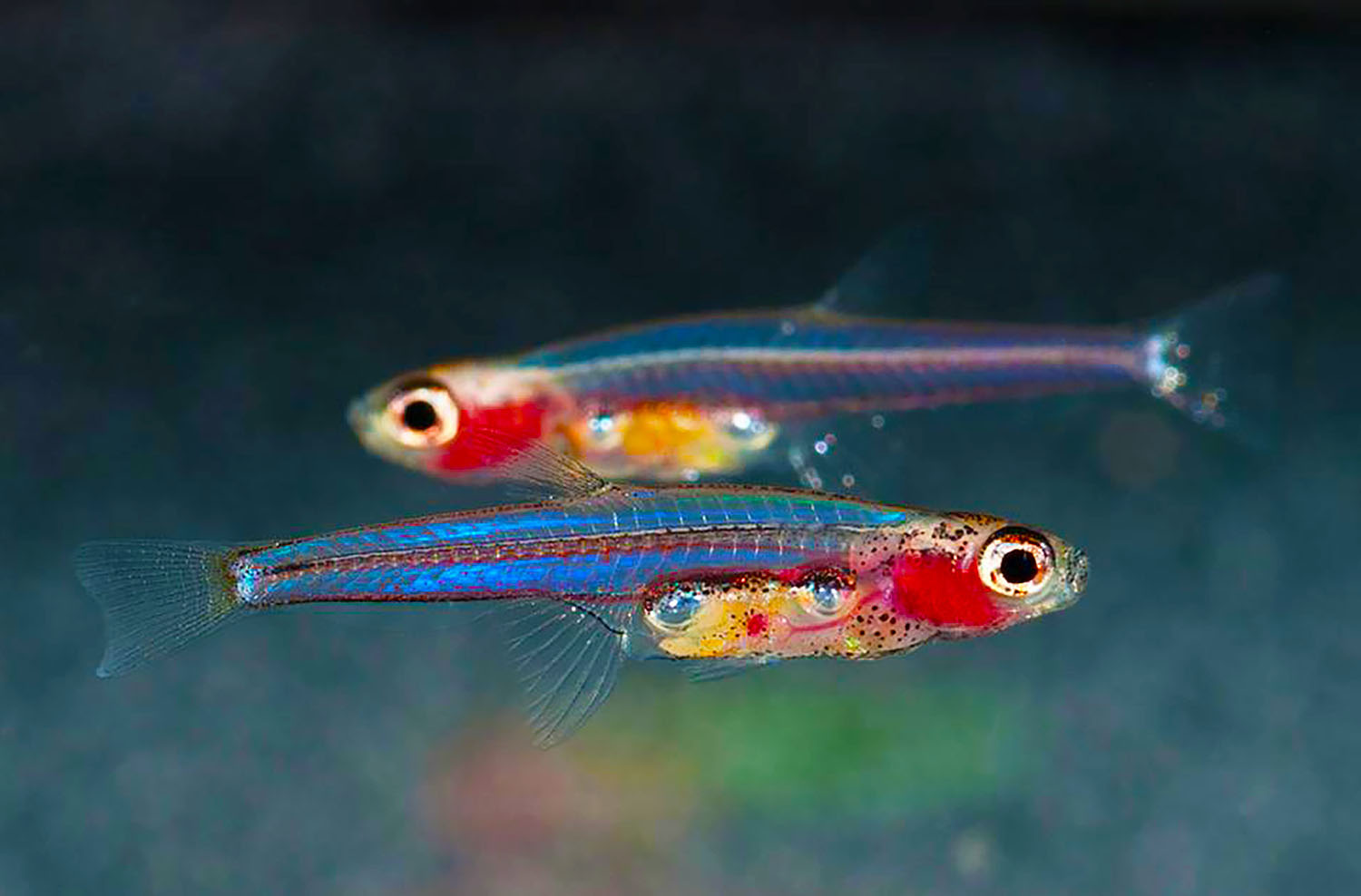
Paedocypris progenetica, the worlds' smallest vertebrate fish.
Coral reefs are the classic example of this aspect, being among the most diverse ecosystems on the planet and serving as natural nurseries for a multitude of marine species, providing a valuable habitat for many fish, mollusks, crustaceans and other organisms.
Kelp forests also play an important role, providing essential habitats and supporting the complex food chain that underpins marine biodiversity. Posidonia meadows, which cover between 20% and 50% of the seabed (or more than 2 million hectares) in the Mediterranean, are another example of an ecosystem that provides several fundamental services for flora and fauna, notably as a place of life, reproduction or refuge for several marine species, as well as a swell damper, source of food, water oxygenation and carbon sink. Marine ecosystems also play a crucial role in regulating water quality, acting as natural filters and absorbing certain pollutants that might otherwise contaminate oceans and coastal areas.
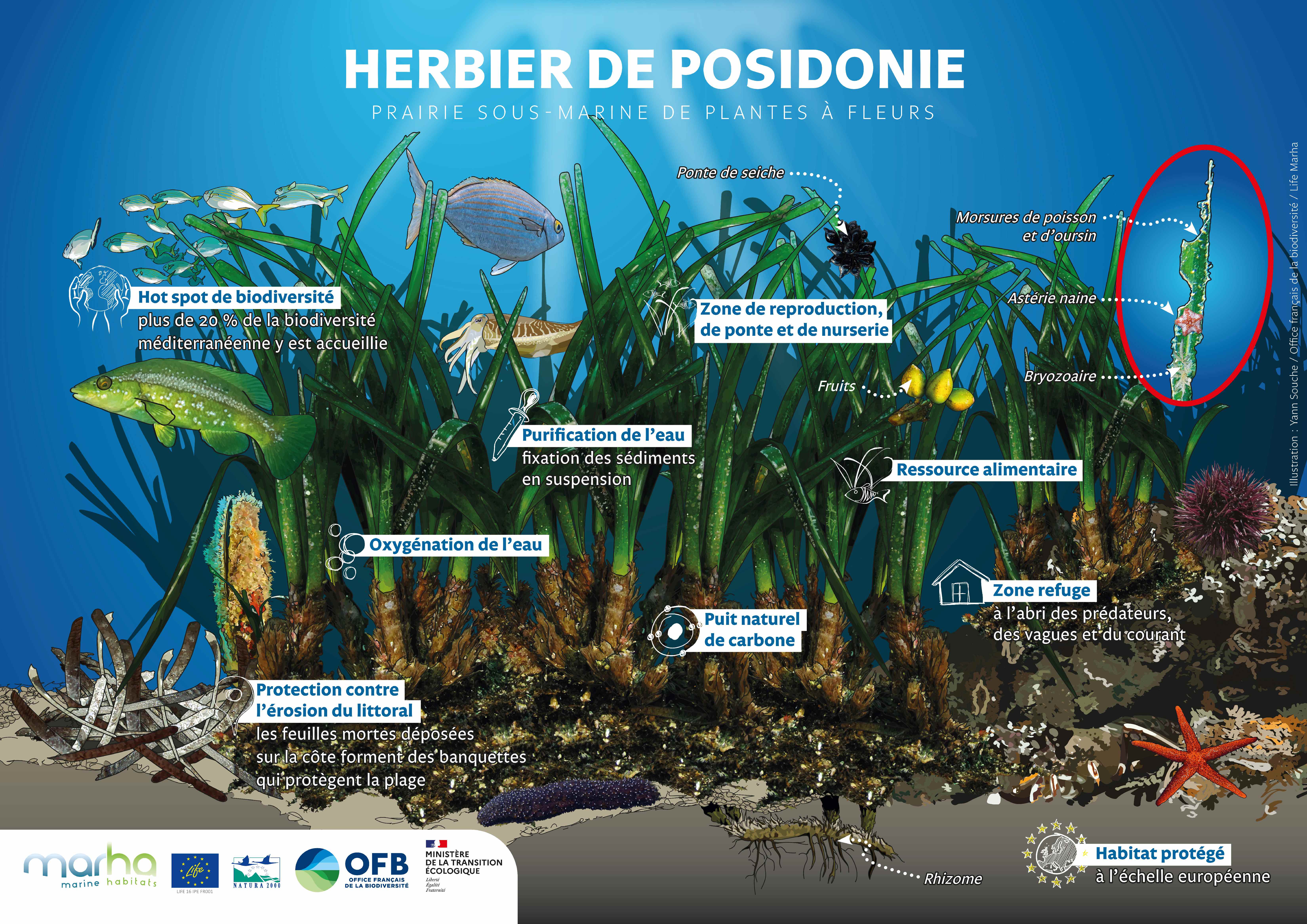
Ecosystem services provided by the Posidonia meadow. Illustration created as part of the Life Marha project, 60% funded by the European Union.
Globally, the ocean represents over 90% of the habitable volume available to the living world and is home to around 80% of the world's life. According to estimates by the International Union for Conservation of Nature (IUCN), the total number of species inhabiting the oceans is close to several million (or even several billion if we consider the microbial world), and only around 250,000 are currently listed. Less than 25% of the ocean has been mapped to date. This proportion drops to just 5% for the deep seabed, such as the bathypelagic zones (located at depths of between 1,000 and 3,000 meters) and the abyssal plains (located at depths of
between 3,000 and 6,000 meters), which are still largely unknown because difficult to access.
It is also estimated that 95% of the ocean's living mass is made up of microorganisms such as phytoplankton and zooplankton, which are at the origin of most marine food chains. However, only 20% to 30% of planktonic organisms are known, and almost nothing about marine bacteria and viruses is known.
This demonstrates the immense biological diversity in the open sea and deep seabed, which is necessary to support the cycle of essential nutrients such as nitrogen and phosphorus that sustain life for flora and fauna. Marine biogeochemical processes, such as nitrogen fixation and nutrient recycling by planktonic micro-organisms, are vital for maintaining the overall stability of ecosystems. This genetic diversity also holds enormous potential in terms of research and development (R&D). It promises undreamt-of benefits for science, notably in terms of bioprospecting (with new molecules that can be valorized as the basis for drugs, food supplements or cosmetics) and biomimicry - an approach that imitates the properties of living organisms and enables the design of innovative structures and materials. According to its proponents, biomimicry also offers the advantage of not simply exploiting nature by using its biological properties, which would inevitably lead to species extinction, but of imitating it and thus obtaining more sustainable and environmentally friendly solutions. After all, nature is just 3.8 billion years ahead of us in R&D experience, according to Janine Benyus, the biologist and author who popularized the term "biomimicry" back in 1997. Among the applications explored in this field of research are ceramics inspired by mother-of-pearl, hydrodynamic coatings (textile or paint) based on the microstructure of shark skins, or even the global optimization of artificial neural networks following the dynamic programming algorithm borrowed from coral reefs.
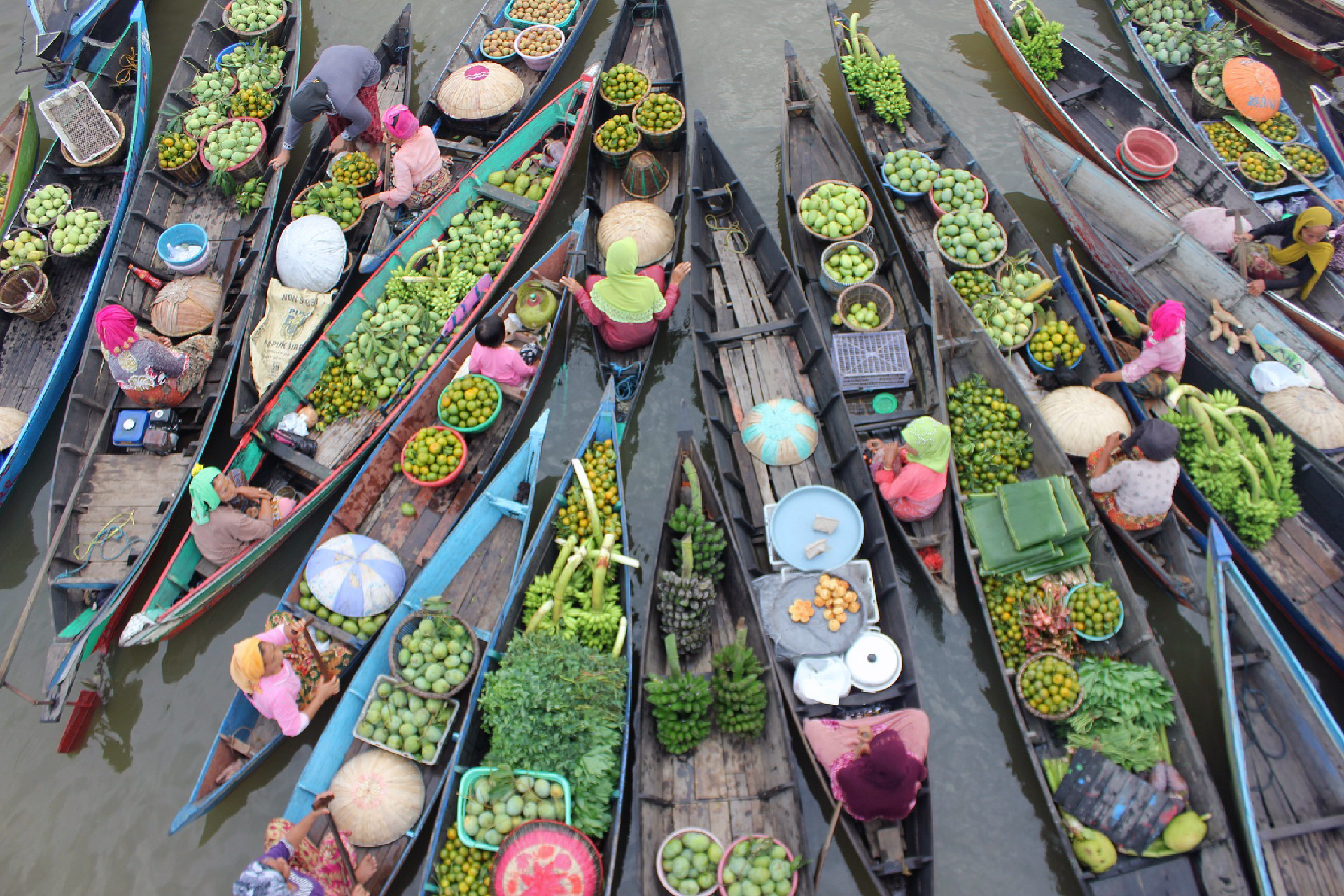
The floating markets of Southeast Asia are part of the world's cultural heritage. Here, the Lok Baintan market in Indonesia.
Guarantor of our Well-being
The ocean is of profound cultural importance to many human societies worldwide, inspiring visual art, music, literature, sports and even spirituality. These cultural services are nonmaterial benefits often overlooked when considering the ocean's value, as they are challenging to quantify. And yet, indigenous peoples such as the Polynesians and the Inuit have always had very close ties with the ocean, viewing it as a fullfledged living entity and not just in a utilitarian sense as a source of food, materials or transportation. We have always had a fascination for these vast blue expanses. Their immensity and particular beauty are reflected in Greek mythology and ancient tales but also in many artistic creations and rituals existing today. For example, the Ong Chun ceremony – also known as Wangchuan or Wangkang – in China and Malaysia, listed as a UNESCO intangible cultural heritage since 2020, or the village purification rituals and offerings to the sea – known as Bersih desa and Petik laut - practised on the island of Java celebrate maritime heritage by paying homage to the ocean and highlighting its importance in our daily lives, symbolising our deep connection with nature. As another example, the floating markets of Southeast Asia, such as Damnoen Saduak in Thailand or Phong Dien in Vietnam, have also become part of our cultural heritage.
Let's also not forget the benefits of aesthetic pleasure and leisure offered by sandy beaches and coastal areas that attract millions of tourists every year. These provide opportunities for relaxation and discovery, and contribute to the economic development of coastal regions. Thus, the coastline plays an important role in our mental and physical well-being.
In the silence of their immensity, ocean expanses offer a diverse range of ecosystem services, often vital. They are an essential link in the planetary health chain, and protecting their good condition is becoming urgent today. Ensuring the health of the oceans means ensuring the health of humankind.
To be read also in the dossier "Seas at risk":




